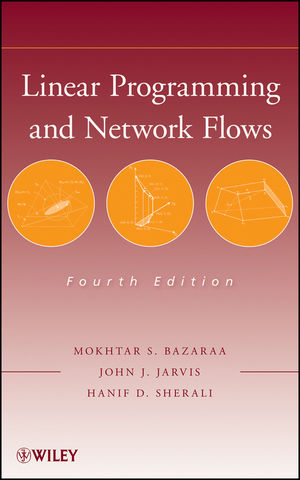Linear Programming and Network Flows, 4th EditionISBN: 978-0-470-46272-0
Hardcover
768 pages
December 2009
 This is a Print-on-Demand title. It will be printed specifically to fill your order. Please allow an additional 15-20 days delivery time. The book is not returnable.
|
||||||
ONE: INTRODUCTION.
1.1 The Linear Programming Problem.
1.2 Linear Programming Modeling and Examples.
1.3 Geometric Solution.
1.4 The Requirement Space.
1.5 Notation.
Exercises.
Notes and References.
TWO: LINEAR ALGEBRA, CONVEX ANALYSIS, AND POLYHEDRAL SETS.
2.1 Vectors.
2.2 Matrices.
2.3 Simultaneous Linear Equations.
2.4 Convex Sets and Convex Functions.
2.5 Polyhedral Sets and Polyhedral Cones.
2.6 Extreme Points, Faces, Directions, and Extreme Directions of Polyhedral Sets: Geometric Insights.
2.7 Representation of Polyhedral Sets.
Exercises.
Notes and References.
THREE: THE SIMPLEX METHOD.
3.1 Extreme Points and Optimality.
3.2 Basic Feasible Solutions.
3.3 Key to the Simplex Method.
3.4 Geometric Motivation of the Simplex Method.
3.5 Algebra of the Simplex Method.
3.6 Termination: Optimality and Unboundedness.
3.7 The Simplex Method.
3.8 The Simplex Method in Tableau Format.
3.9 Block Pivoting.
Exercises.
Notes and References.
FOUR: STARTING SOLUTION AND CONVERGENCE.
4.1 The Initial Basic Feasible Solution.
4.2 The Two-Phase Method.
4.3 The Big-M Method.
4.4 How Big Should Big-M Be?
4.5 The Single Artificial Variable Technique.
4.6 Degeneracy, Cycling, and Stalling.
4.7 Validation of Cycling Prevention Rules.
Exercises.
Notes and References.
FIVE: SPECIAL SIMPLEX IMPLEMENTATIONS AND OPTIMALITY CONDITIONS.
5.1 The Revised Simplex Method.
5.2 The Simplex Method for Bounded Variables.
5.3 Farkas’ Lemma via the Simplex Method.
5.4 The Karush-Kuhn-Tucker Optimality Conditions.
Exercises.
Notes and References.
SIX: DUALITY AND SENSITIVITY ANALYSIS.
6.1 Formulation of the Dual Problem.
6.2 Primal-Dual Relationships.
6.3 Economic Interpretation of the Dual.
6.4 The Dual Simplex Method.
6.5 The Primal-Dual Method.
6.6 Finding an Initial Dual Feasible Solution: The Artificial Constraint Technique.
6.7 Sensitivity Analysis.
6.8 Parametric Analysis.
Exercises.
Notes and References.
SEVEN: THE DECOMPOSITION PRINCIPLE.
7.1 The Decomposition Algorithm.
7.2 Numerical Example.
7.3 Getting Started.
7.4 The Case of Unbounded Region X.
7.5 Block Diagonal or Angular Structure.
7.6 Duality and Relationships with other Decomposition Procedures.
Exercises.
Notes and References.
EIGHT: COMPLEXITY OF THE SIMPLEX ALGORITHM AND POLYNOMIAL-TIME ALGORITHMS.
8.1 Polynomial Complexity Issues.
8.2 Computational Complexity of the Simplex Algorithm.
8.3 Khachian’s Ellipsoid Algorithm.
8.4 Karmarkar’s Projective Algorithm.
8.5 Analysis of Karmarkar’s Algorithm: Convergence, Complexity, Sliding Objective Method, and Basic Optimal Solutions.
8.6 Affine Scaling, Primal-Dual Path-Following, and Predictor-Corrector Variants of Interior Point Methods.
Exercises.
Notes and References.
NINE: MINIMAL-COST NETWORK FLOWS.
9.1 The Minimal-Cost Network Flow Problem.
9.2 Some Basic Definitions and Terminology from Graph Theory.
9.3 Properties of the A Matrix.
9.4 Representation of a Nonbasic Vector in Terms of the Basic Vectors.
9.5 The Simplex Method for Network Flow Problems.
9.6 An Example of the Network Simplex Method.
9.7 Finding an Initial Basic Feasible Solution.
9.8 Network Flows with Lower and Upper Bounds.
9.9 The Simplex Tableau Associated with a Network Flow Problem.
9.10 List Structures for Implementing the Network Simplex Algorithm.
9.11 Degeneracy, Cycling, and Stalling.
9.12 Generalized Network Problems.
Exercises.
Notes and References.
TEN: THE TRANSPORTATION AND ASSIGNMENT PROBLEMS.
10.1 Definition of the Transportation Problem.
10.2 Properties of the A Matrix.
10.3 Representation of a Nonbasic Vector in Terms of the Basic Vectors.
10.4 The Simplex Method for Transportation Problems.
10.5 Illustrative Examples and a Note on Degeneracy.
10.6 The Simplex Tableau Associated with a Transportation Tableau.
10.7 The Assignment Problem: (Kuhn’s) Hungarian Algorithm.
10.8 Alternating Path Basis Algorithm for Assignment Problems.
10.9 A Polynomial-Time Successive Shortest Path Approach for Assignment Problems.
10.10 The Transshipment Problem.
Exercises.
Notes and References.
ELEVEN: THE OUT-OF-KILTER ALGORITHM.
11.1 The Out-of-Kilter Formulation of a Minimal Cost Network Flow Problem.
11.2 Strategy of the Out-of-Kilter Algorithm.
11.3 Summary of the Out-of-Kilter Algorithm.
11.4 An Example of the Out-of-Kilter Algorithm.
11.5 A Labeling Procedure for the Out-of-Kilter Algorithm.
11.6 Insight into Changes in Primal and Dual Function Values.
11.7 Relaxation Algorithms.
Exercises.
Notes and References.
TWELVE: MAXIMAL FLOW, SHORTEST PATH, MULTICOMMODITY FLOW, AND NETWORK SYNTHESIS PROBLEMS.
12.1 The Maximal Flow Problem.
12.2 The Shortest Path Problem.
12.3 Polynomial-Time Shortest Path Algorithms for Networks Having Arbitrary Costs.
12.4 Multicommodity Flows.
12.5 Characterization of a Basis for the Multicommodity Minimal-Cost Flow Problem.
12.6 Synthesis of Multiterminal Flow Networks.
Exercises.
Notes and References.
BIBLIOGRAPHY.
INDEX.



